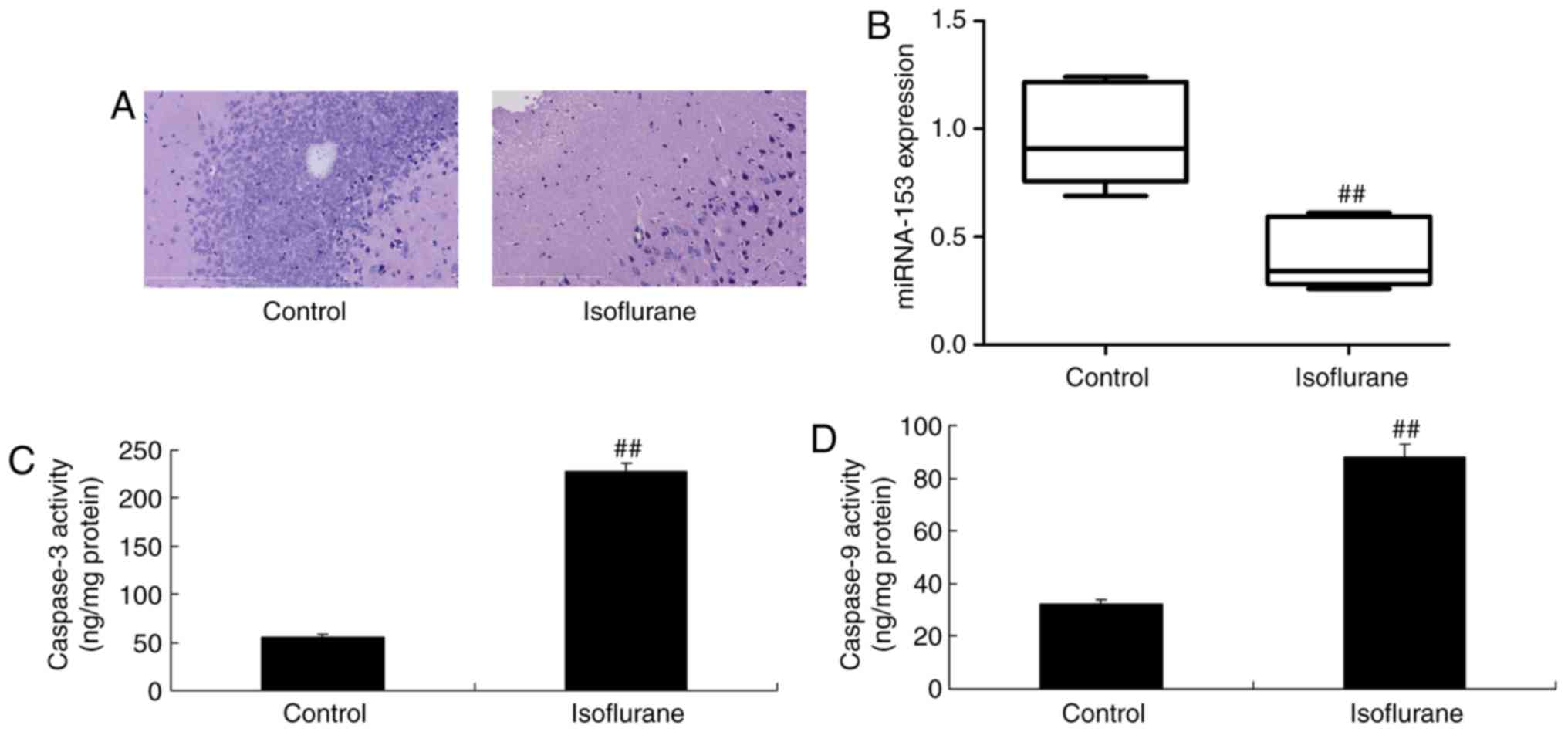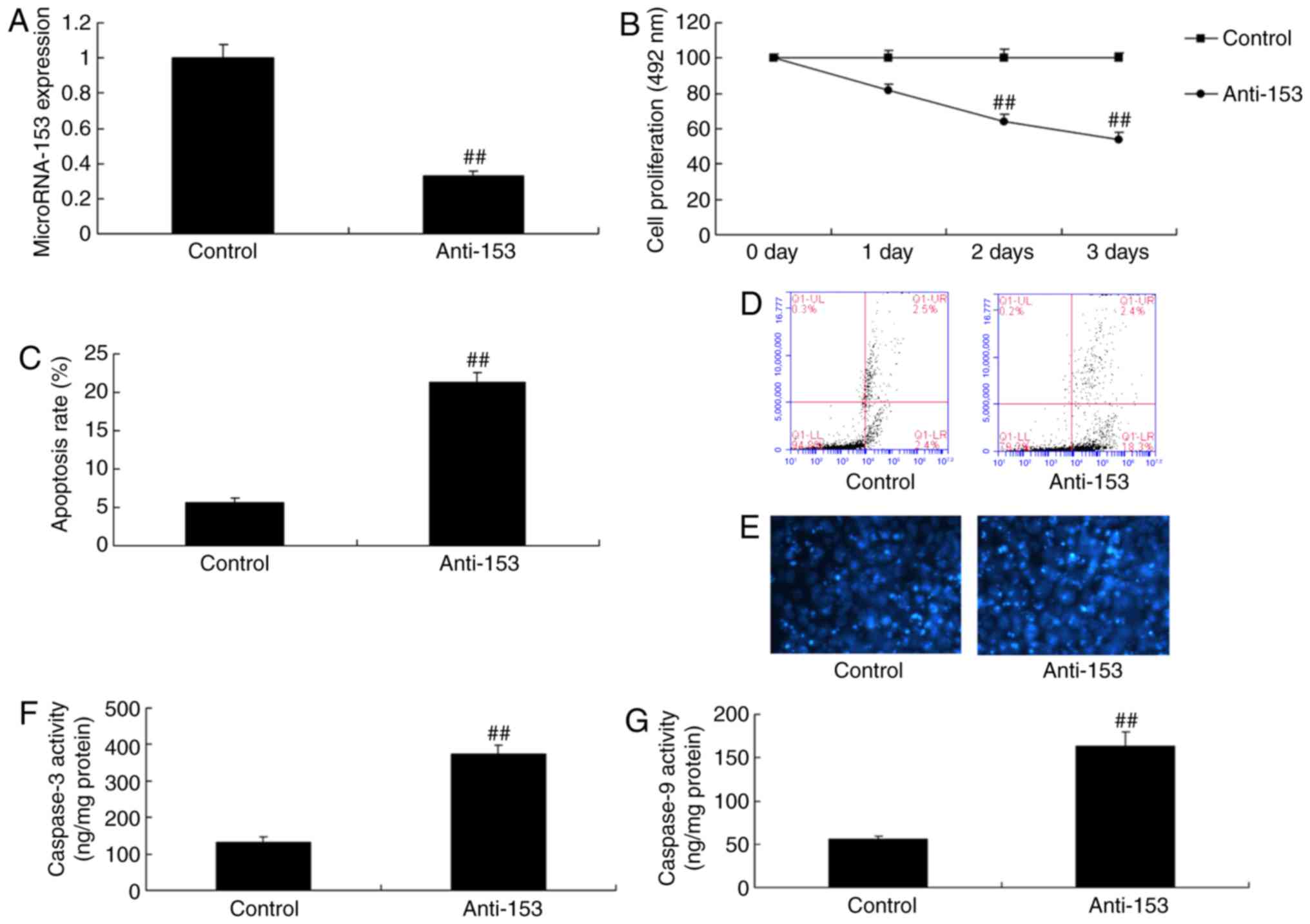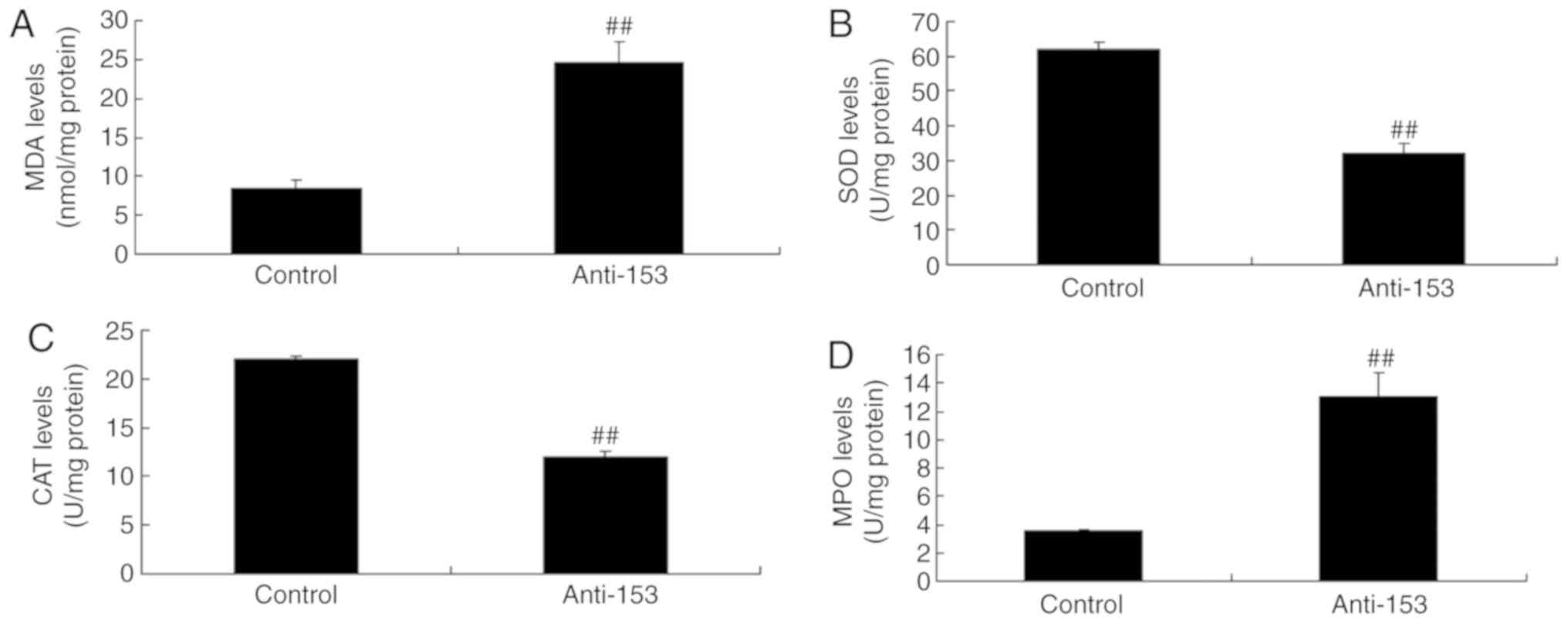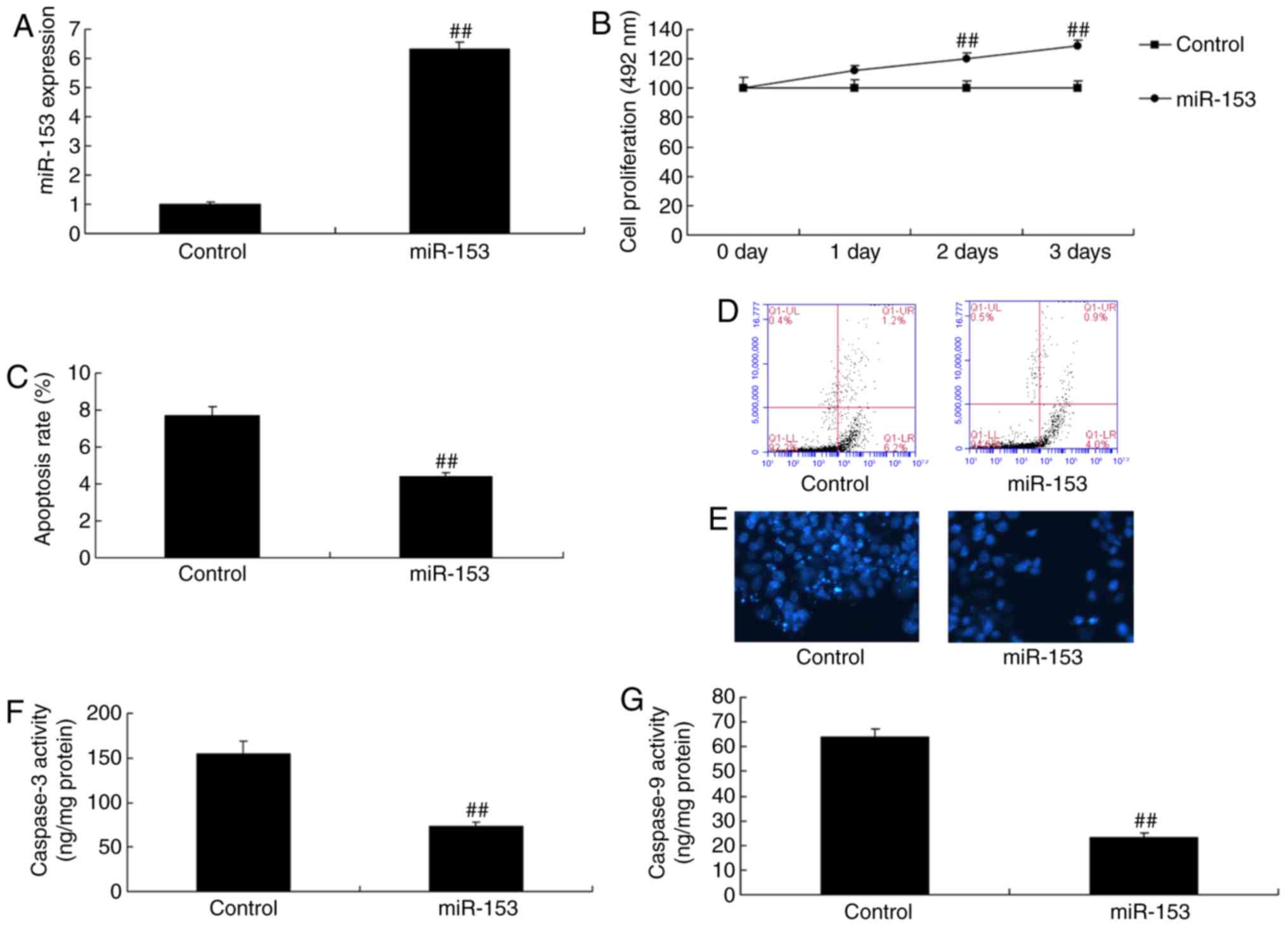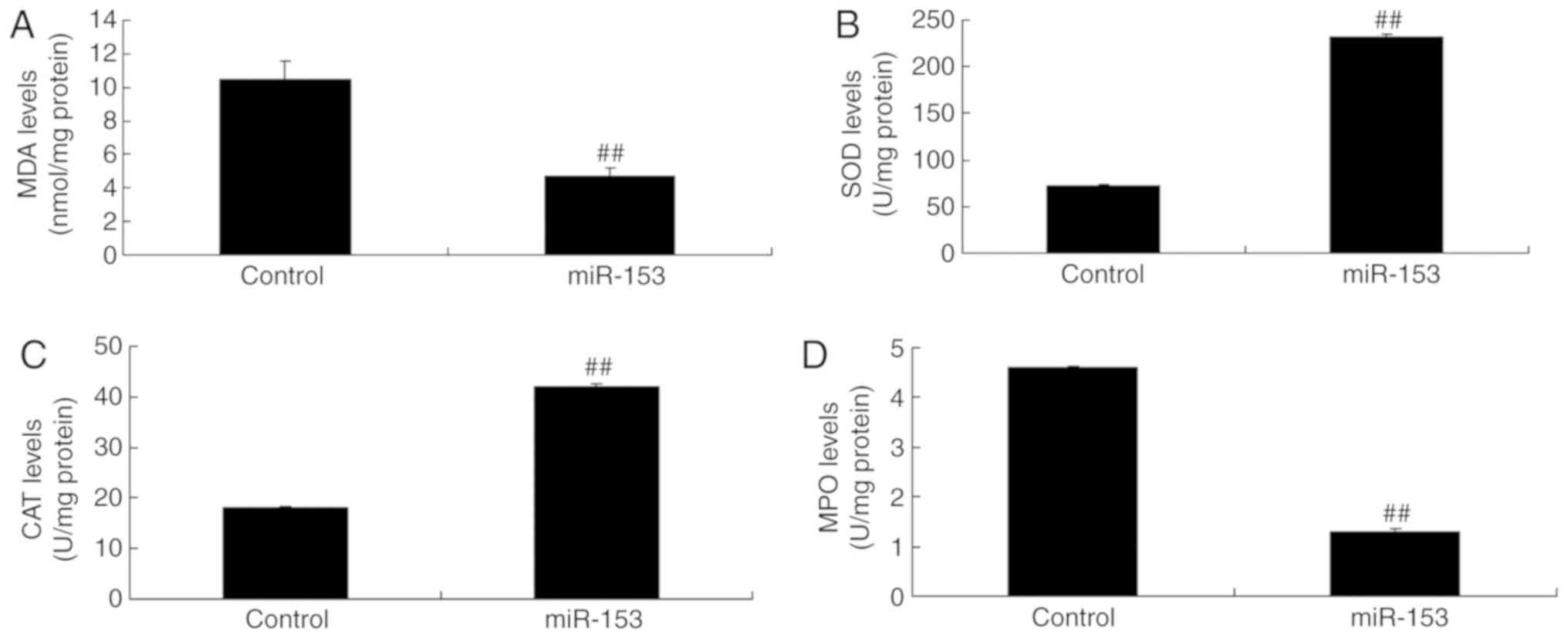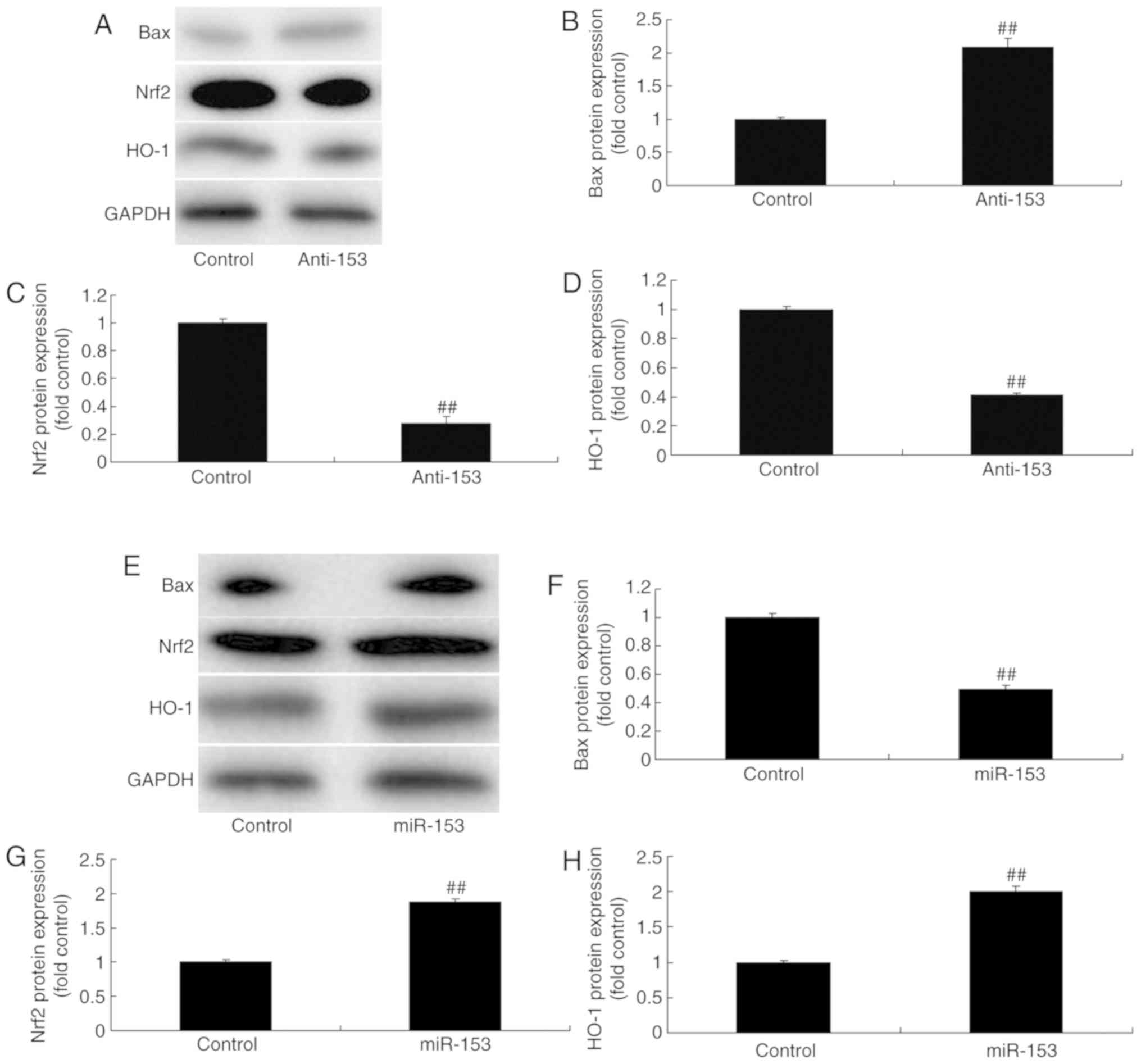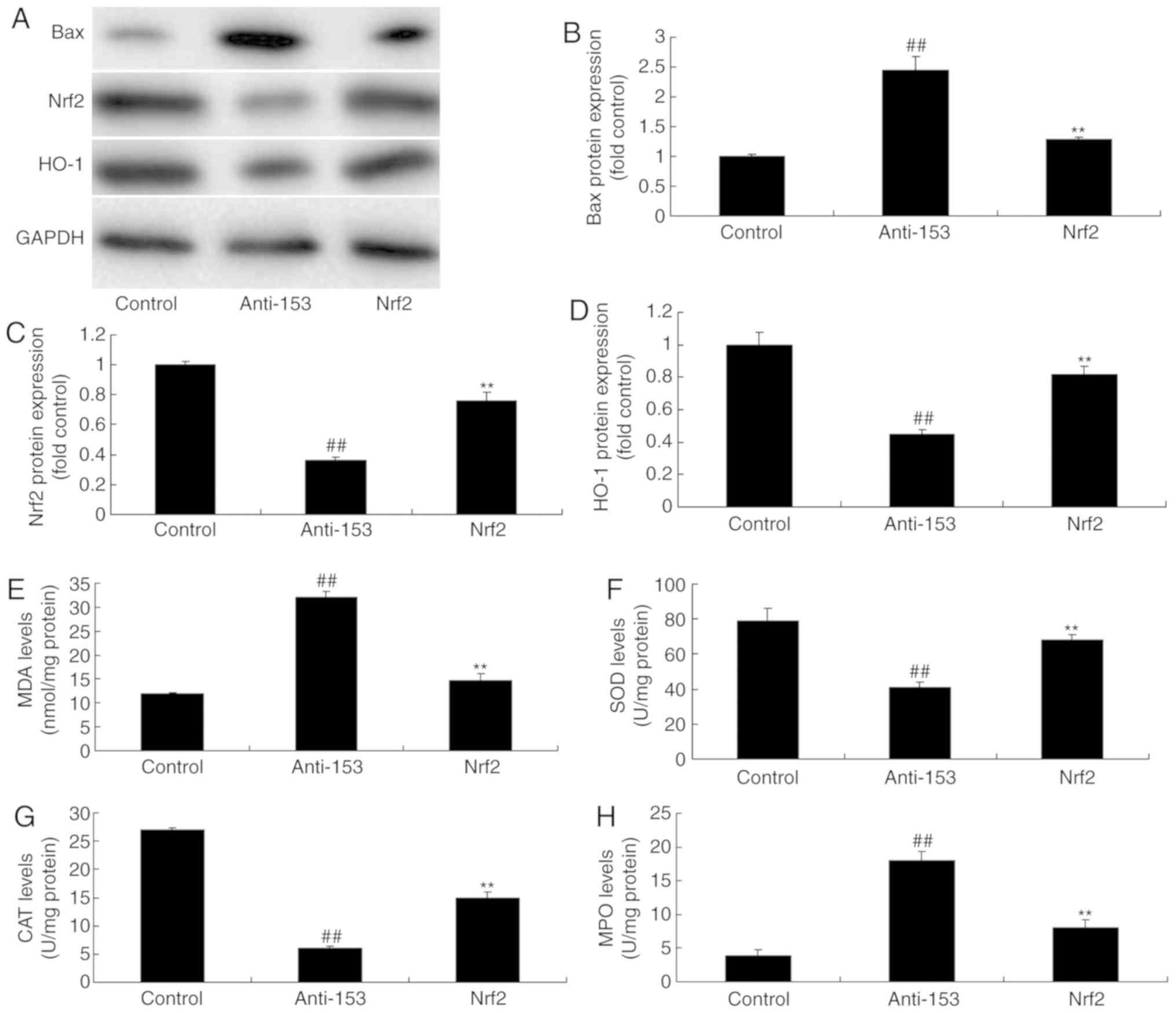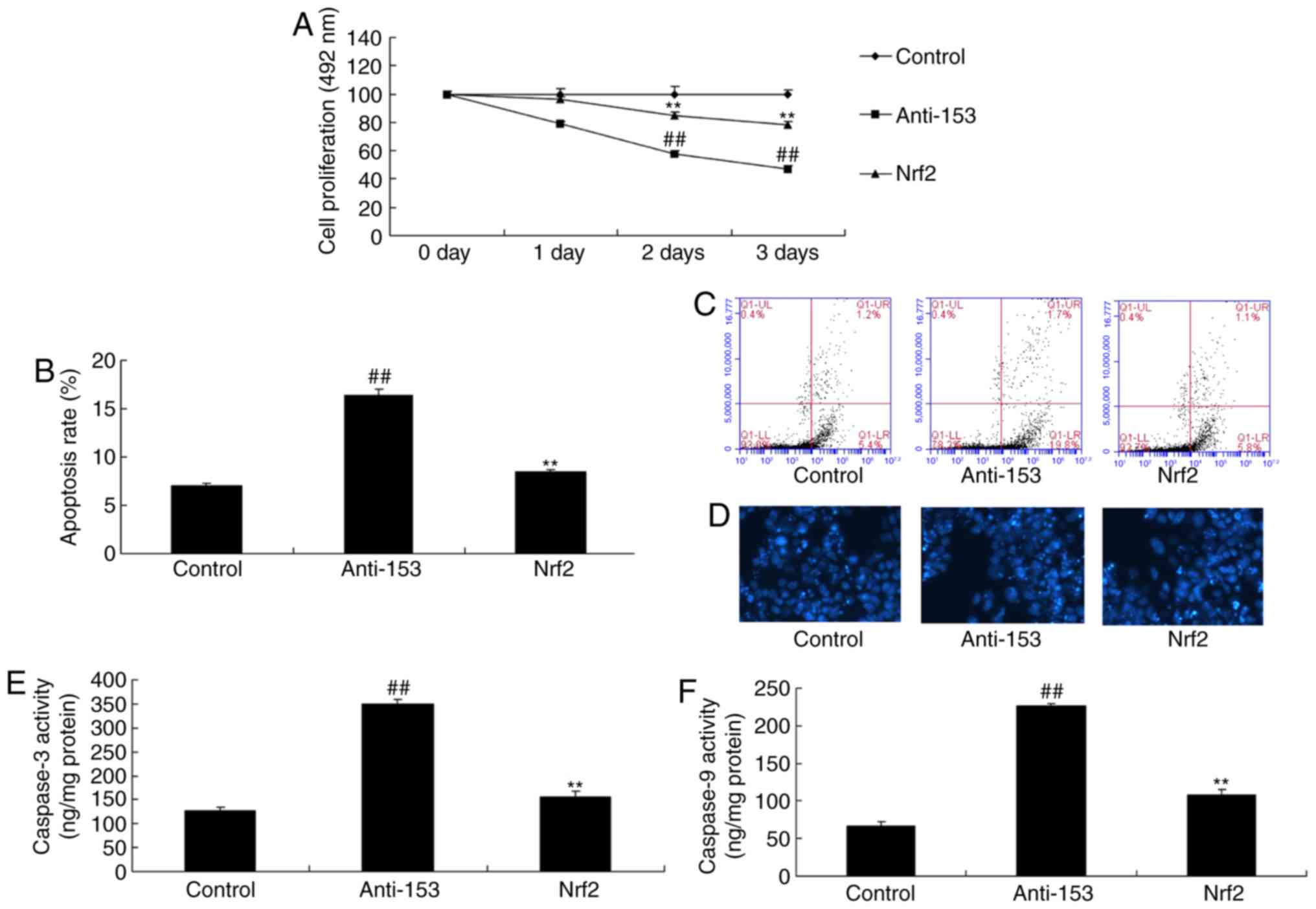The function of miRNA‑153 against isoflurane‑induced neurotoxicity via Nrf2/ARE cytoprotection
- Authors:
- Published online on: March 19, 2019 https://doi.org/10.3892/mmr.2019.10056
- Pages: 4001-4010
-
Copyright: © Shao et al. This is an open access article distributed under the terms of Creative Commons Attribution License.
Abstract
Introduction
Isoflurane is one of the common inhalational anesthetics applied in the clinic (1). The influence of isoflurane on infant neural development has attracted great attention from doctors and patients. Research has indicated that isoflurane may affect the development of the central nervous system (2). In addition, it may cause post-developmental cognitive decline in infants and young animals (2). Additionally, it may damage the activity and function of hippocampal neural stem cells within newborn rats. As a result, isoflurane may promote neuronal apoptosis, affecting neural systemic development, leading to individual cognitive dysfunction (3). However, the precise molecular mechanism by which isoflurane acts on neural stem cells and affects neural development remains unclear.
The oxidative stress theory serves a vital role in the mechanism of neurotoxicity (4), and has attracted extensive attention in recent years (4). Oxidative stress refers to cytotoxic effects generated by reactive oxygen species (ROS), including superoxide anion free radical (O-2), hydroxyl radical (OH) and hydrogen peroxide (H2O2) (4). These ROS are produced as by-products using oxygen molecules during normal and abnormal metabolic processes. Oxidative stress serves an important role in foreign compound-induced neurotoxic effects. In addition, it may inhibit the activities of brain catalase (CAT), superoxide dismutase (SOD) and glutathione peroxidase (GSH-Px). Finally, it leads to decreased brain antioxidant function (5).
Oxidative stress is the stress damage state induced by the imbalance between cellular oxidation and antioxidants (6). Oxidative stress may stimulate cells to produce a large amount of active oxygen radicals (6). This can directly injure the neurons and lead to cytomembrane lipid peroxidation and increased membrane permeability (7). Finally, it may lead to neuronal swelling, degeneration and loss of function (7). Oxidative stress is involved in the early initiation of the neuron apoptotic signaling pathway (8). In addition, it serves a vital role in the genesis and development of neurodegenerative disease (8). Therefore, understanding and research on oxidative stress is of great value in terms of theory and application.
In recent years, the role of the oxidative stress response in the genesis and development of diabetes has attracted attention (9). The close association between these two has been extensively verified (9). The nuclear erythroid-2 related factor 2 (Nrf2)/antioxidant response element (ARE) signaling pathway is the most important endogenous antioxidative stress pathway in the human body. Its association with diabetes is of great interest (10). Nrf2 belongs to the leucine zipper activating transcription factor family and is a vital nuclear transcription factor regulating antioxidative stress (11). Additionally, it serves a central regulatory role in cellular anti-oxidative process (9).
It has been verified that over 200 endogenous genes are regulated by the Nrf2/ARE signaling pathway (10). They include heme oxygenase-1 (HO-1), SOD, CAT, quinone reductase 1, glutathione-s-transferase (GST), glutamate-cysteine ligase and epoxide hydrolase (11). The expression products of these activated genes serve important roles in numerous processes. They include antioxidative stress, the anti-inflammatory response, antiapoptosis, neurotoxicity, immunoregulation and detoxification processes (11). In addition, they can act against the progression of numerous pathological processes. Regulating the activity of such pathway exerts multiple actions in anti-atherosclerosis, antitumor, anti-aging, as well as heart, liver, microvascular and neural protection. Zhang et al (12) demonstrated that Tanshinone IIA protects against 6-hydroxydopamine-induced neurotoxicity via the miR-153-mediated Nrf2/ARE signaling pathway. The present study aimed to investigate the function of microRNA (miR/miRNA)-153 against isoflurane-induced neurotoxicity and the underlying mechanism.
Materials and methods
Mouse model
Wild-type C57BL/6J male mice (n=12; aged 5–6 weeks old; weight, 18–20 g) were purchased from Laboratory Animal Center of Suzhou University (Suzhou, China), and housed in a controlled environment (20–22°C; 55–60% humidity, 12-h light/dark on a reversed light cycle, free access to food and water) and randomly assigned to the isoflurane-anesthesia group (n=6) or the control group (n=6). In the control group, mice received an intraperitoneal injection of 100 µl normal saline. In the isoflurane-anesthesia group, mice received 1.4% isoflurane and 100% oxygen for 2 h using identical flow rates (2 l/min, Ohmeda; GE Healthcare, Chicago, IL, USA) as described in the literature (13). After 2 h, mice from both groups were sacrificed and employed for further analysis. The present study was approved by the ethics committee of the Changzhou No. 2 People's Hospital Affiliated to Nanjing Medical University (Chanzhou, China).
Hematoxylin and eosin staining
Hippocampal tissues were isolated and then washed with PBS and then fixed using 4% paraformaldehyde for 24 h at room temperature. Following this tissues were cut and embedded in paraffin (5 µM). Sections were then stained using 0.1% hematoxylin and eosin stain for 10 min at room temperature, and subsequently visualized using an epifluorescence microscope (magnification, ×100; Zeiss Axiovert 200M; Carl Zeiss AG, Oberkochen, Germany) and analyzed using Image Lab 3.0 software (Bio-Rad Laboratories, Inc., Hercules, CA, USA).
Cell culture and transient transfection
Pc12 cells were purchased from the Cell Bank of Type Culture Collection of Chinese Academy of Sciences (Shanghai, China) and cultured in high-glucose Dulbecco's modified Eagle's medium (Gibco; Thermo Fisher Scientific, Inc., Waltham, MA, USA) containing 10% heat-inactivated fetal calf serum (Gibco; Thermo Fisher Scientific, Inc.), 100 U/ml penicillin, 100 µg/ml streptomycin and 2 mM L-glutamine at 37°C in a 5% CO2. miRNA-153 (5′-UUGCAUAGUCACAAAAGUGAUC-3′), anti-miRNA-153 (5′-UUGCAUAGUCACAAAAGUGAUC-3′) and negative mimics (5′-CCCCCCCCCCCCCCCCCCCCCC-3′) were purchased from Sangon Biotech Co., Ltd. (Shanghai, China). miRNA-153 (100 ng), anti-miRNA-153 (100 ng) and negative mimics (100 ng) were transfected into Pc12 cells (1×106 cells/ml) using Lipofectamine® 2000 (Invitrogen; Thermo Fisher Scientific, Inc.). Following transfection at 4 h, the old medium was removed and cells were treated with 2% isoflurane plus 21% O2 and 5% CO2 for 6 h as described previously (13). A total of 4 h post-transfection, the Nrf2 agonist dimethyl fumarate (2.5 µM) was incubated with the cells for 44 h at 37°C, and the cells were treated with 2% isoflurane, 21% O2 and 5% CO2 for 6 h at 37°C.
Reverse transcription-quantitative polymerase chain reaction (RT-qPCR) analysis of cellular miRNA and mRNA levels
Total RNA was extracted from tissue samples and cell using TRIzol reagent (Invitrogen; Thermo Fisher Scientific, Inc.). Total RNA was reverse-transcribed into cDNA using a TaqMan MicroRNA Reverse Transcription kit (Applied Biosystems; Thermo Fisher Scientific, Inc.) at 37°C for 60 min and 85°C for 1 min. RT-qPCR was conducted using a Maxima SYBR Green PCR kit (Thermo Fisher Scientific Inc.). The following thermocycling conditions were used for qPCR: 95°C for 10 min; followed by 40 cycles at 95°C for 15 sec, 60°C for 30 sec and 72°C for 30 sec. The 2−ΔΔCq method was used for quantification (14). The following primers were used: miRNA-153 forward, 5′-TCTCAACTGGTGTCGTGGAGTCGGCAATTCAGTTGAGGATCACTTT-3′ and reverse, 5′-ACACTCCAGCTGGGTTGCATAGTCACAAAAGT-3′; U6 forward, 5′-CGCTTCACGAATTTGCGTGTCAT-3′ and reverse, 5′-GCTTCGGCAGCACATATACTAAAAT-3′.
ELISA assay
Extracts from harvested cells were subjected to western blot analyses using radioimmunoprecipitation assay (RIPA) buffer (Beyotime Institute of Biotechnology, Haimen, China) and protein content was measured using a Bicinchoninic Acid (BCA) protein assay (Beyotime Institute of Biotechnology). A total of 10 µg proteins were used to measure SOD (cat. no. A001-1-1), CAT (cat. no. A007-1-1), MPO (cat. no. A044) and malondialdehyde (MDA; cat. no. A003-1) levels using ELISA kits according to the manufacturer's protocol (Nanjing Jiancheng Bioengineering Institute, Nanjing, China).
MTT assay
Following isoflurane-induced neurotoxicity at 24, 48 and 72 h, cells were stained with 20 µl volume of 5 mg/ml MTT dye (Sigma-Aldrich; Merck KGaA, Darmstadt, Germany) and incubated for 4 h at 37°C. Subsequently, 150 µl dimethylsulfoxide (Invitrogen; Thermo Fisher Scientific, Inc.) was added to each cell and agitated for 20 min at 37°C. The optical density was determined at 490 nm using a Versamax microplate reader (Molecular Devices, LLC, Sunnyvale, CA, USA).
Flow cytometric detection of apoptosis
Following isoflurane-induced neurotoxicity at 48 h, cell were washed twice with ice-cold PBS prior to being harvested and stained with 5 µl Annexin V-fluorescein isothiocyanate and 5 µl propidium iodide (cat. no. 550911; BD Biosciences, Franklin Lakes, NJ, USA) for 15 min per treatment at room temperature in darkness. Apoptosis was analyzed using a flow cytometer (BD C6 flow cytometer; BD Biosciences) and FlowJo software (version 7.6.1; FlowJo, LLC, Ashland, OR, USA).
DAPI assay
Cells were washed with PBS and fixed with 4% paraformaldehyde for 15 min at room temperature. Cells were blocked with 5% bovine serum albumin (Beyotime Institute of Biotechnology) in PBS for 1 h at room temperature and then incubated with DAPI (5 mg/ml; Beyotime Institute of Biotechnology) for 30 min in the dark at room temperature. Cells were washed with PBS and subsequently visualized using an epifluorescence microscope (magnification, ×100; Zeiss Axiovert 200M; Carl Zeiss AG).
Western blotting
Extracts from harvested cells were subjected to western blot analyses using RIPA buffer; protein content was measured using a BCA assay. A total of 30–50 µg protein were separated and concentrated using an 8–12% SDS-PAGE gel, and then electrotransferred onto polyvinylidene fluoride (PVDF) membranes (Merck KGaA). PVDF membranes were blocked with 5%-non-milk in TBS with 0.1% Tween 20 for 1 h at 37°C and incubated with B-cell lymphoma-2 (Bcl-2)-associated X (Bax; cat. no. sc-20067; 1:500; Santa Cruz Biotechnology, Inc., Dallas, TX, USA), Nrf2 (cat. no. sc-722; 1:500; Santa Cruz Biotechnology, Inc.), HO-1 (cat. no. sc-10789; 1:500; Santa Cruz Biotechnology, Inc.) and GAPDH (cat. no. 5174; 1:5,000; Cell Signaling Technology, Inc., Danvers, MA, USA) at 4°C overnight. PVDF membranes were incubated with an anti-rabbit IgG (H+L) secondary antibody (cat. no. 14708; 1:5,000; Cell Signaling Technology, Inc.) then detected by using enzymatic chemiluminescence kit (Beyotime Institute of Biotechnology) and analyzed using Image Lab 3.0 software (Bio-Rad Laboratories, Inc.).
Determination of Caspase-3/9 activities
The activity levels of Caspase-3/9 proteins were analyzed using 10 µg protein obtained from extracted cells and Caspase-3/9 activities kits (cat nos. C1115 and C1157, respectively; Beyotime Institute of Biotechnology). Optical densities were determined at 405 nm using a Versamax microplate reader (Molecular Devices, LLC, Sunnyvale, CA, USA).
Statistical analysis
Data were expressed as the mean ± standard deviation using SPSS 19.0 (IBM Corp., Armonk, NY, USA). The Student's t-test was used to analyze the differences between two groups; one-way analysis of variance followed by Tukey's post hoc test was used to analyze the differences between multiple groups. P<0.05 was considered to indicate a statistically significant difference. All experiments were repeated in triplicate.
Results
miRNA-153 expression
Hematoxylin and eosin staining of hippocampal sections indicated the inhibition of neurocytes in isoflurane-induced mice, compared with in the control group (Fig. 1A). As present in Fig. 1B, qPCR demonstrated that the miRNA-153 expression was significantly downregulated within isoflurane-induced mice, compared with in the control group (P<0.01). Additionally, significant increases in caspase-3/9 activities were observed within isoflurane-induced mice, compared with in the control group (P<0.01; Fig. 1C and D). These results demonstrated that miRNA-153 may participate in isoflurane-induced neurocyte apoptosis.
Downregulation of miRNA-153 induces neurocyte apoptosis in vitro
miRNA-153 expression was reduced in vitro using anti-miRNA-153 expression mimics. As presented in Fig. 2A, a significant inhibition of miRNA-153 expression within the in vitro model was observed, compared with in the control group (P<0.01). Subsequently, the downregulation of miRNA-153 induced neurocyte apoptosis and reduced cell growth in vitro, compared with in the control group (P<0.01; Fig. 2B-D). Downregulation of miRNA-153 significantly increased DAPI and caspase-3 and caspase-9 activity in vitro, compared with in the control group (Fig. 2E-G).
Downregulation of miRNA-153 induces oxidative stress in vitro
Downregulation of miRNA-153 induced neurocyte apoptosis in vitro; the effects of miRNA-153 on oxidative stress were investigated in an in vitro model. As presented in Fig. 3, the downregulation of miRNA-153 significantly reduced SOD and CAT expression levels, and induced MDA and MPO expression levels in an in vitro model of isoflurane-induced neurotoxicity, compared with in the control group (P<0.01).
Overexpression of miRNA-153 reduces neurocyte apoptosis in the in vitro model
miRNA-153 mimics significantly increased the expression of miRNA-153 in vitro, compared with in the control group (P<0.01; Fig. 4A). Overexpression of miRNA-153 significantly reduced neurocyte apoptosis and promoted cell growth in the in vitro model, compared with in the control group (P<0.01; Fig. 4B-E). Overexpression of miRNA-153 significantly suppressed caspase-3 and caspase-9 activity in an in vitro model of isoflurane-induced neurotoxicity, compared with in the control group (P<0.01; Fig. 4F and G).
Overexpression of miRNA-153 reduces oxidative stress in an in vitro model
Overexpression of miRNA-153 increased SOD and CAT expression levels, and reduced MDA and MPO expression levels in an in vitro model of isoflurane-induced neurotoxicity, compared with in the control group (Fig. 5). These results demonstrated that miRNA-153 regulated oxidative stress to induce apoptosis in an in vitro model of isoflurane-induced neurotoxicity.
Regulation of miRNA-153 affects Nrf2/ARE signaling pathway in an in vitro model
In order to investigate the mechanisms of miRNA-153 on oxidative stress in vitro, the alterations of Nrf2/ARE signaling pathway were analyzed. As presented in Fig 6A-D, the downregulation of miRNA-153 suppressed Nrf2/HO-1 protein expression and induced Bax protein expression in an in vitro model of isoflurane-induced neurotoxicity, compared with in the control group. Overexpression of miRNA-153 induced Nrf2/HO-1 protein expression and significantly suppressed Bax protein expression in an in vitro model of isoflurane-induced neurotoxicity, compared with in the control group (P<0.01; Fig. 6E-H).
Nrf2 agonist induces the Nrf2/ARE signaling pathway and reduces oxidative stress to induce neurocyte apoptosis in vitro following anti-miRNA-153 transfection
The role of the Nrf2/ARE signaling pathway on the effects of anti-miRNA-153 were further investigated in an in vitro model of isoflurane-induced neurotoxicity. The Nrf2 agonist significantly induced Nrf2 and HO-1 protein expression, and suppressed Bax protein expression in cells transfected with anti-miRNA-153, compared with the anti-miRNA-153 group (Fig. 7A-D). The Nrf2 agonist increased SOD and CAT expression levels, and reduced MDA and MPO expression levels an in vitro model of isoflurane-induced neurotoxicity following anti-miRNA-153 transfection, compared with the anti-miRNA-153 group (Fig. 7E-H). Compared with in the anti-miRNA-153 group, the Nrf2 agonist inhibited the effects of anti-miRNA-153 on the promotion of neurocyte apoptosis, inhibition of cell growth and induction of caspase-3/9 activity in an in vitro model of isoflurane-induced neurotoxicity following anti-miRNA-153, compared with in the anti-miRNA-153 group (Fig. 8).
Discussion
Research has indicated that acute inhalation anesthetic exposure to isoflurane may result in hippocampal neuron apoptosis in developmental rats (3). Furthermore, it may also lead to reduced learning and memory ability (15); however, evidence has been contradictory (15). Nonetheless, studies indicate that anesthetics exposure in postnatal animals during the sensitive neural developmental period will lead to neuron histopathological injury (15). Additionally, apoptosis has been observed in all parts of the brain, which may result in subsequent decreases in learning and memory ability (15).
Numerous processes are involved in the development of the mammalian nervous system (16), including neurogenesis, differentiation, migration, synaptogenesis, myelinogenesis and neuron apoptosis (16). Apoptosis can remove the excessive neurons during development, but is rarely observed under normal conditions (16). Apoptosis can be achieved via the endogenous and exogenous pathways and induces the activation of caspases. Activation of the endogenous pathway includes downregulation of Bcl-2 family proteins expression and enhanced mitochondrial permeability. Cytochrome c outflow, as well as the activation of caspase 9 and caspase 3 are also involved (17). Activation of the exogenous pathway includes the formation of the apoptosis induction signal peptide complex, as well as the activation of caspase 8 and caspase 3 (17). Therefore, caspase 3 is the common factor of endogenous and exogenous apoptosis pathways. In the present study the downregulation of miRNA-153 induced neurocyte apoptosis and reduced cell growth in an in vitro model of isoflurane-induced neurotoxicity via Bax-caspase-3/9 activity. Zou et al (18) demonstrated that miR-153 regulates apoptosis and autophagy of cardiomyocytes by targeting Mcl-1.
Free radicals serve a critical role in cerebral ischemia, cerebral injury, Parkinson's disease, amyotrophic lateral sclerosis, Down's syndrome and Alzheimer's disease (19). The nervous system is richer in lipid composition compared with other tissues (20) and has high oxygen consumption (20). Therefore, it is sensitive to free radical injury. Excessive oxidative injury may affect subsequent life processes (20). SOD, CAT and GSH-Px are the important enzymes in the antioxidant system (4). Their activities may directly reflect the levels of mitochondrial antioxidant system function (20). Excessive manganese inhibition can weaken the action of SOD on superoxide anion. This may result in the accumulation of free radicals in the body (20). Additionally, catecholamine reactions, including excessive free radical catalysis or accelerated dopamine may increase free radical formation and may accelerate lipid peroxidation and induce neuron degeneration and necrosis (21).
Nrf2 is an important antioxidative stress transcription factor; HO-1 is a vital antioxidant enzyme against endogenous and exogenous stimulation and can protect cells (10). Nrf2 will translocate into the nucleus following activation. In this manner, Nrf2 may bind with the ARE. Therefore, it may initiate HO-1 expression and a series of antioxidation mechanisms (22,23). In the present study, the overexpression of miRNA-153 induced the Nrf2/ARE signaling pathway within a model of isoflurane-induced neurotoxicity, compared with in the control group. Wang et al (24) demonstrated that miRNA-153 regulates NRF2 expression, decreases apoptosis and increases the colony formation ability of breast epithelial cells.
Nrf2 is an important transcription factor regulating the antioxidative stress response; Kelch-like ECH-associated protein1 (Keap1) is its specific receptor (25). Under normal conditions, Keap1 and Nrf2 will form a complex in the cytoplasm to inhibit Nrf2 activity. Under oxidative stress, Keap1 will dissociate with Nrf2 (25). Subsequently, Nrf2 may bind with ARE following nuclear translocation (26). This will initiate the expression of ARE-regulated phase II detoxifying enzymes and antioxidase genes. Finally, it will enhance cellular resistance to oxidative stress and nucleophilic compounds. ARE-regulated antioxidant genes include HO-1 and GST, which can protect the body from ROS. Investigation has verified that a Nrf2 knockout mouse exhibited aggravated cerebral ischemic injury. In addition, activating the Keap1/Nrf2/ARE signaling pathway and promoting HO-1 expression may alleviate neurotoxicity (23). Zhang et al (12) suggested that Tanshinone IIA may protect dopaminergic neurons against 6-hydroxydopamine-induced neurotoxicity via the miR-153/Nrf2/ARE signaling pathway. The present study reported that the Nrf2 agonist dimethyl fumarate (2.5 µM), induced the Nrf2/ARE signaling pathway and reduced oxidative stress to induce neurocyte apoptosis in vitro following anti-miRNA-153. Ji et al (27) indicated that the inhibition of microRNA-153 may protect neurons against ischemia/reperfusion injury via Nrf2/HO-1 signaling in an oxygen-glucose deprivation and reoxygenation cellular model.
In conclusion, the results of the present study suggested that the function of miRNA-153 against neurotoxicity and apoptosis via the activation of Nrf2/ARE cytoprotection. This may be associated with the upregulation of miRNA-153/Nrf2/ARE in isoflurane-induced neurotoxicity and may provide a promising therapeutic target for neurotoxicity following anesthesia.
Acknowledgements
Not applicable.
Funding
No funding was received.
Availability of data and materials
The datasets used and/or analyzed during the current study are available from the corresponding author on reasonable request.
Authors' contributions
ZZ designed the present study; DS, ZW, SB and GF performed the experiments; ZZ and DS analyzed the data; ZZ wrote the manuscript. All authors read and approved the final manuscript.
Ethics approval and consent to participate
The present study was approved by the Ethics Committee of the Changzhou No. 2 People's Hospital Affiliated to Nanjing Medical University (Chanzhou, China).
Patient consent for publication
Not applicable.
Competing interests
The authors declare that they have no competing interests.
References
|
Zhang B, Tian M, Zhen Y, Yue Y, Sherman J, Zheng H, Li S, Tanzi RE, Marcantonio ER and Xie Z: The effects of isoflurane and desflurane on cognitive function in humans. Anesth Analg. 114:410–415. 2012. View Article : Google Scholar : PubMed/NCBI | |
|
Lemkuil BP, Head BP, Pearn ML, Patel HH, Drummond JC and Patel PM: Isoflurane neurotoxicity is mediated by p75NTR-RhoA activation and actin depolymerization. Anesthesiology. 114:49–57. 2011. View Article : Google Scholar : PubMed/NCBI | |
|
Chen L, Zhang B, Shan S and Zhao X: Neuroprotective effects of vitexin against isoflurane-induced neurotoxicity by targeting the TRPV1 and NR2B signaling pathways. Mol Med Rep. 14:5607–5613. 2016. View Article : Google Scholar : PubMed/NCBI | |
|
Li C, Hou L, Chen D, Lin F, Chang T, Li M, Zhang L, Niu X, Wang H, Fu S and Zheng J: Hydrogen-rich saline attenuates isoflurane-induced caspase-3 activation and cognitive impairment via inhibition of isoflurane-induced oxidative stress, mitochondrial dysfunction, and reduction in ATP levels. Am J Transl Res. 9:1162–1172. 2017.PubMed/NCBI | |
|
Sun J, Chen XL, Zheng JY, Zhou JW and Ma ZL: Astragaloside IV protects new born rats from anesthesia-induced apoptosis in the developing brain. Exp Ther Med. 12:1829–1835. 2016. View Article : Google Scholar : PubMed/NCBI | |
|
Abdul-Aziz A, MacEwan DJ, Bowles KM and Rushworth SA: Oxidative stress responses and NRF2 in human leukaemia. Oxid Med Cell Longev. 2015:4546592015. View Article : Google Scholar : PubMed/NCBI | |
|
Song Zh, Tong G, Xiao K, Jiao le F, Ke Yl and Hu Ch: L-cysteine protects intestinal integrity, attenuates intestinal inflammation and oxidant stress, and modulates NF-κB and Nrf2 pathways in weaned piglets after LPS challenge. Innate Immun. 22:152–161. 2016. View Article : Google Scholar : PubMed/NCBI | |
|
Bartolini D and Galli F: The functional interactome of GSTP: A regulatory biomolecular network at the interface with the Nrf2 adaption response to oxidative stress. J Chromatogr B Analyt Technol Biomed Life Sci. 1019:29–44. 2016. View Article : Google Scholar : PubMed/NCBI | |
|
Shen C, Cheng W, Yu P, Wang L, Zhou L, Zeng L and Yang Q: Resveratrol pretreatment attenuates injury and promotes proliferation of neural stem cells following oxygen-glucose deprivation/reoxygenation by upregulating the expression of Nrf2, HO-1 and NQO1 in vitro. Mol Med Rep. 14:3646–3654. 2016. View Article : Google Scholar : PubMed/NCBI | |
|
Jiang LJ, Zhang SM, Li CW, Tang JY, Che FY and Lu YC: Roles of the Nrf2/HO-1 pathway in the anti-oxidative stress response to ischemia-reperfusion brain injury in rats. Eur Rev Med Pharmacol Sci. 21:1532–1540. 2017.PubMed/NCBI | |
|
Sun J, Wei X, Lu Y, Cui M, Li F, Lu J, Liu Y and Zhang X: Glutaredoxin 1 (GRX1) inhibits oxidative stress and apoptosis of chondrocytes by regulating CREB/HO-1 in osteoarthritis. Mol Immunol. 90:211–218. 2017. View Article : Google Scholar : PubMed/NCBI | |
|
Zhang XS, Ha S, Wang XL, Shi YL, Duan SS and Li ZA: Tanshinone IIA protects dopaminergic neurons against 6-hydroxydopamine-induced neurotoxicity through miR-153/NF-E2-related factor 2/antioxidant response element signaling pathway. Neuroscience. 303:489–502. 2015. View Article : Google Scholar : PubMed/NCBI | |
|
Wang W, Zhang J, Li Y, Yang X, He Y, Li T, Ren F, Zhang J and Lin R: Divalproex sodium enhances the anti-leukemic effects of imatinib in chronic myeloid leukemia cells partly through SIRT1. Cancer Lett. 356:791–799. 2015. View Article : Google Scholar : PubMed/NCBI | |
|
Qian C, Jin J, Chen J, Li J, Yu X, Mo H and Chen G: SIRT1 activation by resveratrol reduces brain edema and neuronal apoptosis in an experimental rat subarachnoid hemorrhage model. Mol Med Rep. 16:9627–9635. 2017. View Article : Google Scholar : PubMed/NCBI | |
|
Li G, Xue Q, Luo Y, Hu X and Yu B: S6 inhibition contributes to isoflurane neurotoxicity in the developing brain. Toxicol Lett. 233:102–113. 2015. View Article : Google Scholar : PubMed/NCBI | |
|
Xu Z, Dong Y, Wu X, Zhang J, McAuliffe S, Pan C, Zhang Y, Ichinose F, Yue Y and Xie Z: The potential dual effects of anesthetic isoflurane on Aβ-induced apoptosis. Curr Alzheimer Res. 8:741–752. 2011. View Article : Google Scholar : PubMed/NCBI | |
|
Pan C, Xu Z, Dong Y, Zhang Y, Zhang J, McAuliffe S, Yue Y, Li T and Xie Z: The potential dual effects of anesthetic isoflurane on hypoxia-induced caspase-3 activation and increases in β-site amyloid precursor protein-cleaving enzyme levels. Anesth Analg. 113:145–152. 2011. View Article : Google Scholar : PubMed/NCBI | |
|
Zou Y, Liu W, Zhang J and Xiang D: miR-153 regulates apoptosis and autophagy of cardiomyocytes by targeting Mcl-1. Mol Med Rep. 14:1033–1039. 2016. View Article : Google Scholar : PubMed/NCBI | |
|
Bi J, Zhang H, Lu J and Lei W: Nobiletin ameliorates isoflurane-induced cognitive impairment via antioxidant, anti-inflammatory and anti-apoptotic effects in aging rats. Mol Med Rep. 14:5408–5414. 2016. View Article : Google Scholar : PubMed/NCBI | |
|
Cheng Y, Mitchell-Flack MJ, Wang A and Levy RJ: Carbon monoxide modulates cytochrome oxidase activity and oxidative stress in the developing murine brain during isoflurane exposure. Free Radic Biol Med. 86:191–199. 2015. View Article : Google Scholar : PubMed/NCBI | |
|
Liang C, Zhu H, Xu Y, Huang L, Ma C, Deng W, Liu Y and Qin C: MicroRNA-153 negatively regulates the expression of amyloid precursor protein and amyloid precursor-like protein 2. Brain Res. 1455:103–113. 2012. View Article : Google Scholar : PubMed/NCBI | |
|
Wang Y, Li H, Huang H, Liu S, Mao X, Wang S, Wong SS, Xia Z and Irwin MG: Cardioprotection from emulsified isoflurane postconditioning is lost in rats with streptozotocin-induced diabetes due to the impairment of Brg1/Nrf2/STAT3 signalling. Clin Sci (Lond). 130:801–812. 2016. View Article : Google Scholar : PubMed/NCBI | |
|
Piras S, Furfaro AL, Brondolo L, Passalacqua M, Marinari UM, Pronzato MA and Nitti M: Differentiation impairs Bach1 dependent HO-1 activation and increases sensitivity to oxidative stress in SH-SY5Y neuroblastoma cells. Sci Rep. 7:75682017. View Article : Google Scholar : PubMed/NCBI | |
|
Wang B, Teng Y and Liu Q: MicroRNA-153 regulates NRF2 expression and is associated with breast carcinogenesis. Clin Lab. 62:39–47. 2016. View Article : Google Scholar : PubMed/NCBI | |
|
Sun X, Yang Y, Shi J, Wang C, Yu Z and Zhang H: NOX4- and Nrf2-mediated oxidative stress induced by silver nanoparticles in vascular endothelial cells. J Appl Toxicol. 37:1428–1437. 2017. View Article : Google Scholar : PubMed/NCBI | |
|
Zhang C, Wang HJ, Bao QC, Wang L, Guo TK, Chen WL, Xu LL, Zhou HS, Bian JL, Yang YR, et al: NRF2 promotes breast cancer cell proliferation and metastasis by increasing RhoA/ROCK pathway signal transduction. Oncotarget. 7:73593–73606. 2016.PubMed/NCBI | |
|
Ji Q, Gao J, Zheng Y, Liu X, Zhou Q, Shi C, Yao M and Chen X: Inhibition of microRNA-153 protects neurons against ischemia/reperfusion injury in an oxygen-glucose deprivation and reoxygenation cellular model by regulating Nrf2/HO-1 signaling. J Biochem Mol Toxicol. 31:2017.doi: 10.1002/jbt.21905. View Article : Google Scholar : PubMed/NCBI |



